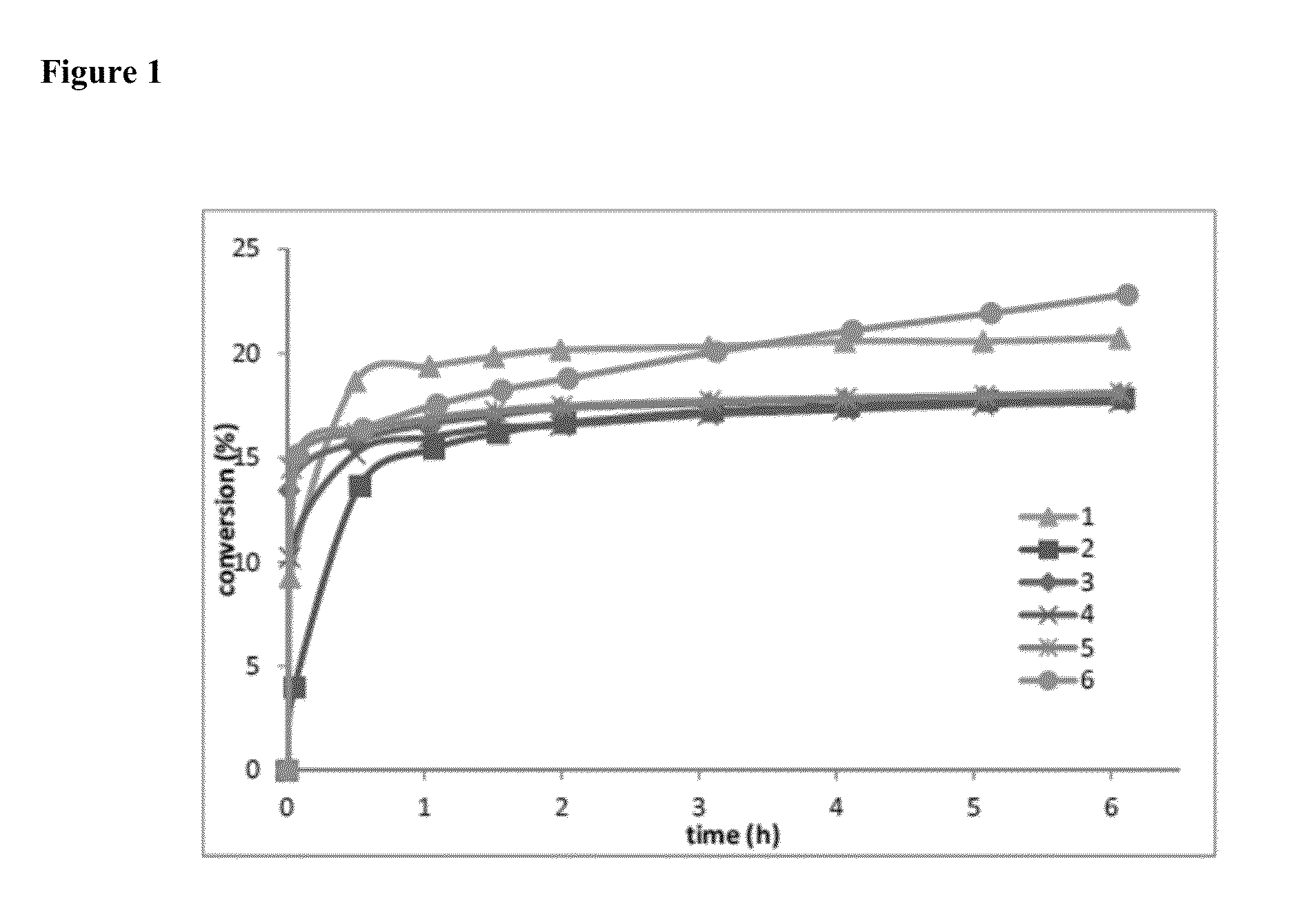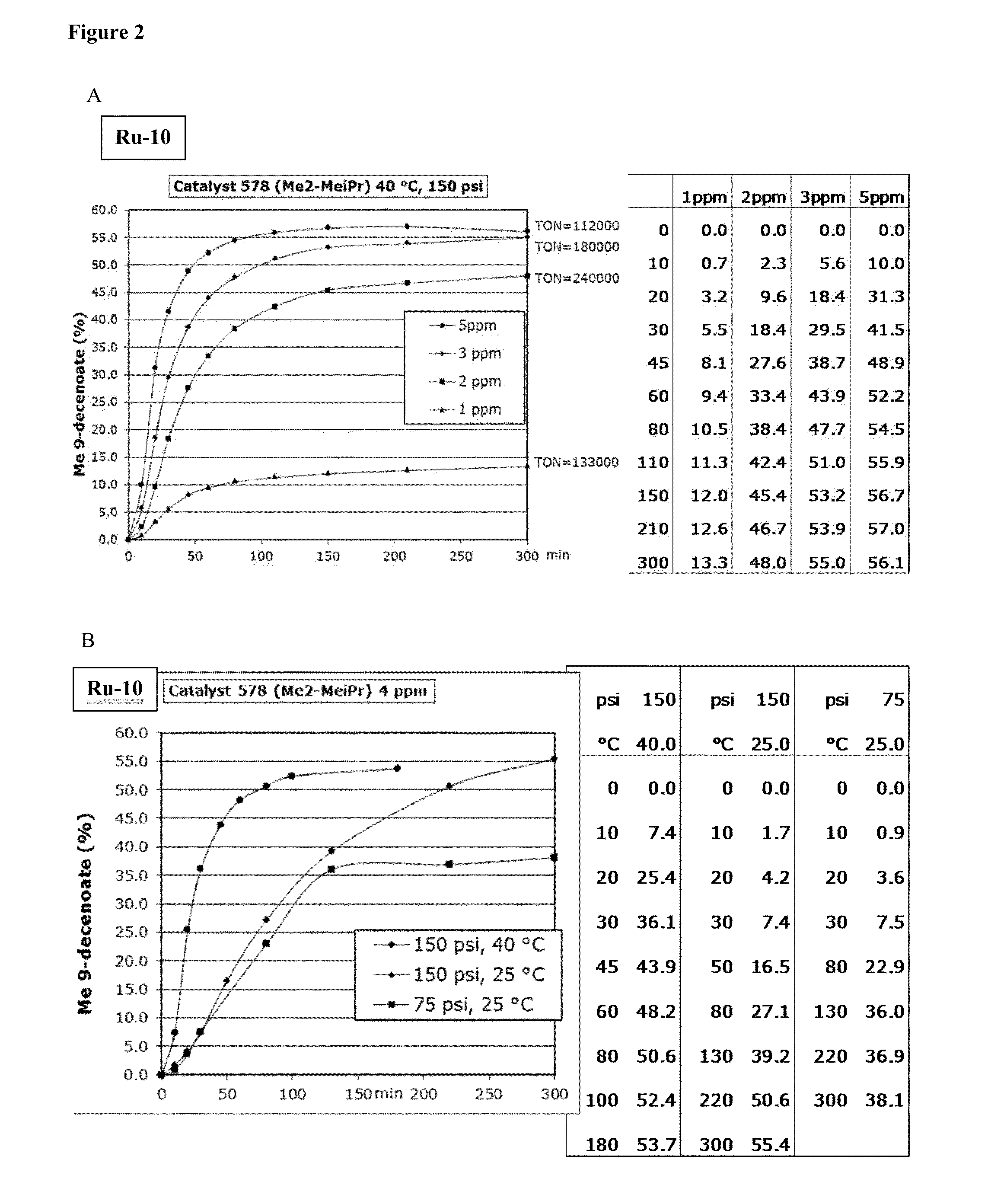Cyclic Alkyl Amino Carbene (CAAC) Ruthenium Complexes as Improved Catalysts for Ethenolysis Reactions
a technology of ruthenium complexes and cyclic alkyl amino carbenes, which is applied in the preparation of ruthenium organic compounds, hydrocarbon preparation catalysts, carboxylic compound preparations, etc., can solve the problem of cost-prohibitive industrial scale parts of the system
- Summary
- Abstract
- Description
- Claims
- Application Information
AI Technical Summary
Benefits of technology
Problems solved by technology
Method used
Image
Examples
example 1
[0144]Ru9-Ru11 (Scheme 2) were synthesized in moderate to excellent yields (20-90%). These catalysts all displayed unprecedented activity in the ethenolysis of methyl oleate (Scheme 3). Specifically, catalysts Ru9 and Ru10, provided TONs>100,000 at only 3 ppm catalyst loading under optimized reaction conditions (Table 1). High purity ethylene (>99%) was used in this experiment; previous studies had utilized lower quality ethylene (>95%), containing significant amounts (>5 ppm) of unsaturated impurities including acetylene. These impurities may lead to premature catalyst death at lower catalyst loadings.
[0145]The backbone substitution of the CAAC ligands was varied. The gem-dimethyl groups of Ru10 may be replaced with only a slight loss in activity (as in Ru13). This small change in the steric environment a to the carbene carbon afforded access to catalysts bearing previously unaccessible N-aryl substituents, such as Ru14 and Ru15 in good conversion (60-80%). Although these catalysts...
example 2
[0149]Initiation rates were measured by reacting catalysts with n-butylvinylether. As a comparison, the initiation rate constants of known catalysts are also included (i.e., Ru4 and SD-Hoveyda (i.e., the second-generation Grubbs-Hoveyda catalyst)). As depicted in Table 2, the less bulky catalysts initiating much faster. The mono-substituted isopropyl derivative Rub initiates especially rapidly, and in fact could not be monitored at 60° C. for direct comparison to the others because the reaction was complete by the time the first data point was obtained at 90 s. It is interesting to note that the MIPP catalyst Ru10 barely reacts until about 50° C.
TABLE 2Catalyst #,TEMPINITIATION RATECATALYSTFIG. 1(° C.)CONSTANT, 10−3 s−1Ru211600.23 ± 0.02Ru112600.24 ± 0.02Ru103600.29 ± 0.03Ru95603.2 ± 0.3Ru8660bRu86301.1 ± 0.1Ru44601.3 ± 0.1SD-Hov307.2 ± 0.2aInitiation rate constants were determined by measuring the decrease in the benzylidene resonance using 1H NMR spectroscopy following addition of...
example 3
[0150]The steady-state cross-metathesis (CM) of 1-hexene (sealed in an NMR tube) (Scheme 4)
was examined to see if a correlation could be made to the selectivity noted in the ethenolysis of methyl oleate. In general, the CAACs seem to exhibit similar selectivity to previously reported N-alkyl N-aryl catalysts (which range from 10-20% conversion). It is interesting that except for the disubstituted N-aryl derivatives, N-aryl substitution does not appear to influence the preference of the catalysts for terminal olefins, however phenyl substitution on the backbone as in 1 (i.e., Ru21) decreases the selectivity somewhat. Also, the monounsubstituted derivative 6 (i.e., Ru8) did not reach a steady state after 6 hours.
[0151]See FIG. 1.
PUM
| Property | Measurement | Unit |
|---|---|---|
| Olefinic | aaaaa | aaaaa |
Abstract
Description
Claims
Application Information
 Login to View More
Login to View More - R&D
- Intellectual Property
- Life Sciences
- Materials
- Tech Scout
- Unparalleled Data Quality
- Higher Quality Content
- 60% Fewer Hallucinations
Browse by: Latest US Patents, China's latest patents, Technical Efficacy Thesaurus, Application Domain, Technology Topic, Popular Technical Reports.
© 2025 PatSnap. All rights reserved.Legal|Privacy policy|Modern Slavery Act Transparency Statement|Sitemap|About US| Contact US: help@patsnap.com



